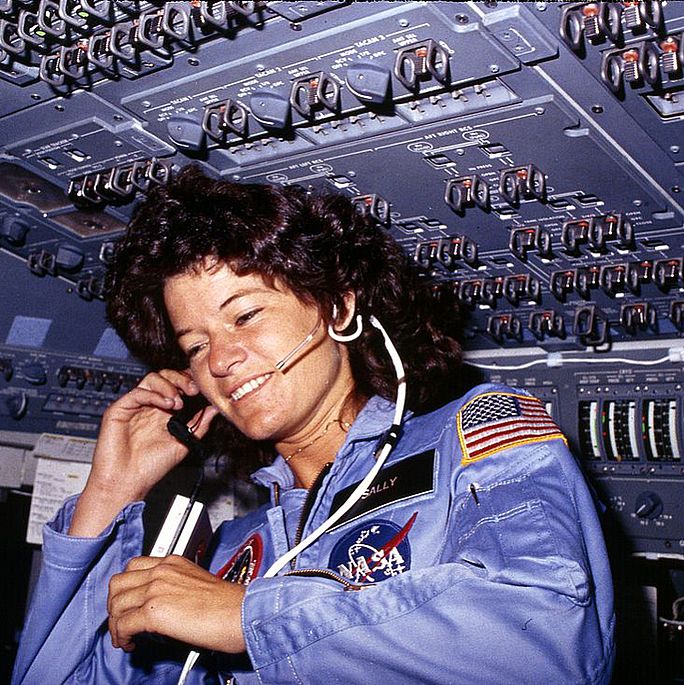Click! in the Classroom
Sally Ride: Educating for
STEM, STEAM, and Space
Grade Level: Grades 3-6 | Estimated Time: One class period |
Introduction
This lesson introduces students to Sally Ride, the first American woman in space. After her retirement from 1987, Ride dedicated her life to helping young people engage with STEM (science, technology, engineering, and math) subjects. She stated that her early educational and career experiences influenced her commitment to the education of young people. Today, this integrated commitment to teaching both STEM and the arts (or the humanities, which includes literature) is called STEAM (science, technology, engineering, arts, and math).
Learning Objective
Students will learn about Sally Ride’s pioneering history as the first American woman in space.
Essential Questions
How can studying both science and the humanities lead to better lives?
Why do humans explore the solar system?
Materials
Technology Needs: Computer with Speakers and Internet Access; Printer/Copier
This Lesson Plan (PDF)
Mind Map (PDF)
Pencils/Pens
Teacher’s Class Preparation
Read “Women’s Work,” a brief overview of the history of American women and work. (Also available as a PDF.)
Read NASA’s “Who Was Sally Ride?” a brief biographical sketch aimed a young readers.
Warm Up Activity: Mind Map and Class Discussion
Place students in pairs and hand out a Mind Map (PDF) to each student.
Have the students put “Astronauts” in the center and then fill in a Mind Map (PDF) with their word associations.
Bring the class back together and open up class discussion about their Mind Maps asking them to share their word associations. Direct the discussion to Sally Ride by noting any associations about women and gender.
Tell the students that they are going to be learning about American women in space, including Sally Ride and Ellen Ochoa.
Main Activity: Small Group/Pair Work and Class Discussion
Divide the class into small groups or have them return to their pairs.
Have each group/pair read the essay on the NASA website’s page “Who Was Sally Ride?”
Have the students discuss the question “Why Do We Explore?”
Have the students play the game “Why Do We Explore?” at the NASA Kid’s Clubhouse. (Note: This game requires Adobe Flash. You may need to use a different browser or computer that can run Adobe Flash content.)
Bring the class back together and continue the discussion about exploration. Emphasize connections between the humanities and the sciences.
Return to a discussion of their Mind Maps.
Discuss how gender stereotypes lead us to think that the world of science is a world of men.
Discuss how Sally Ride, Ellen Ochoa, and many other women disprove this stereotype.
Explain that stereotypes are generalizations.
We use them to categorize people when we don’t know the whole person.
They are built from assumptions, which are ideas we take for granted, and from beliefs, which are ideas passed down to us from authorities.
A stereotype is a wrong idea that all the people in a certain group are the same. It is a wrong idea that all people in a certain group think the same way.
Gender stereotypes influence how we think about what it means to be a “boy” and what it means to be a “girl.” They influence how we interact with other people in the classroom and in the workplace. They influence how we imagine our futures.
Common Core Anchor Standards
Reading
Integration of Knowledge and Ideas:
CCSS.ELA-LITERACY.CCRA.R.7
Integrate and evaluate content presented in diverse media and formats, including visually and quantitatively, as well as in words.
Writing
Research to Build and Present Knowledge:
CCSS.ELA-LITERACY.CCRA.W.8
Gather relevant information from multiple print and digital sources, assess the credibility and accuracy of each source, and integrate the information while avoiding plagiarism.
Language
Knowledge of Language:
CCSS.ELA-LITERACY.CCRA.L.3
Apply knowledge of language to understand how language functions in different contexts, to make effective choices for meaning or style, and to comprehend more fully when reading or listening.
How to Navigate our Interactive Timeline
You will find unique content in each chapter’s timeline.
Place the cursor over the timeline to scroll up and down within the timeline itself. If you place the cursor anywhere else on the page, you can scroll up and down in the whole page – but the timeline won’t scroll.
To see what’s in the timeline beyond the top or bottom of the window, use the white “dragger” located on the right edge of the timeline. (It looks like a small white disk with an up-arrow and a down-arrow attached to it.) If you click on the dragger, you can move the whole timeline up or down, so you can see more of it. If the dragger won’t move any further, then you’ve reached one end of the timeline.
Click on one of the timeline entries and it will display a short description of the subject. It may also include an image, a video, or a link to more information within our website or on another website.
Our timelines are also available in our Resource Library in non-interactive format.
Timeline Legend
Yellow bars mark entries that appear in every chapter
This icon indicates a book
This icon indicates a film
1971 The Click! Moment
The idea of the “Click! moment” was coined by Jane O’Reilly. “The women in the group looked at her, looked at each other, and ... click! A moment of truth. The shock of recognition. Instant sisterhood... Those clicks are coming faster and faster. They were nearly audible last summer, which was a very angry summer for American women. Not redneck-angry from screaming because we are so frustrated and unfulfilled-angry, but clicking-things-into-place-angry, because we have suddenly and shockingly perceived the basic disorder in what has been believed to be the natural order of things.” Article, “The Housewife's Moment of Truth,” published in the first issue of Ms. Magazine and in New York Magazine. Republished in The Girl I Left Behind, by Jane O'Reilly (Macmillan, 1980). Jane O'Reilly papers, Schlesinger Library.


